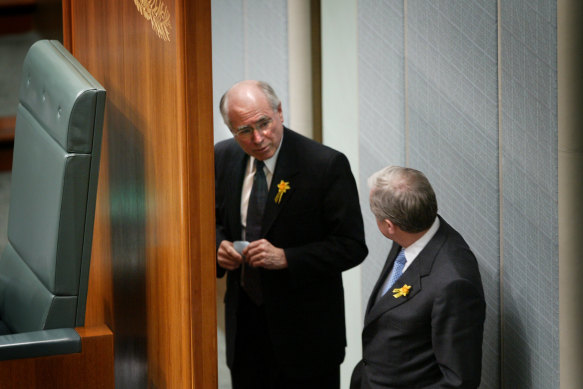This was published 1 year ago
Why John Howard intervened to kill the emissions trading scheme his cabinet wanted
By Shane Wright
John Howard’s cabinet dumped its support for an emissions trading scheme to reduce the nation’s greenhouse emissions after the prime minister warned senior ministers that industry leaders were strongly opposed to the idea.
Cabinet documents released on January 1 by the National Archives show that in 2003 - almost a decade before the Gillard government would introduce its carbon tax – the Howard government backflipped on its moves towards a trading scheme that had been supported by ministers including then-treasurer Peter Costello and foreign minister Alexander Downer.

John Howard talks to then Labor leader Simon Crean in the House of Representatives in August 2003. Days later, Howard would convince his cabinet to dump support for an emissions trading scheme.Credit: Penny Bradfield
The documents show that in the first half of 2003, the issue of how to reduce Australia’s greenhouse gas emissions was a growing concern. The Howard government in 2002 had decided not to ratify the Kyoto Protocol which, unlike almost every other nation, actually gave Australia the ability to increase its emissions.
While opposed to signing the protocol, the government wanted to meet its commitment which forced it to consider ways to bring emissions down.
In a submission that went to cabinet in July and was supported by then environment minister David Kemp, Costello, Downer and then acting industry minister Joe Hockey, an emissions trading scheme was explicitly backed.
Arguing that such a scheme was “likely to be the most cost-effective policy for government”, the ministers said it would not be need to be in place until 2012 – the year the carbon tax ultimately came into operation.
“The preferred approach to the emissions management strategy centres on introduction of a broad-based market signal,” their submission argued.
“An emissions trading system offers the ability to achieve the environmental outcome with certainty when and if this becomes an appropriate choice. Emissions trading is recommended as the preferred market system (in comparison to a greenhouse levy) as it provides greater flexibility in the mechanisms available to provide transitional support for industry.”
In a foreshadowing of the Abbott government’s “direct action” approach to emissions reduction and the Albanese government’s own Capacity Investment Scheme, the ministers warned that simply handing money over to businesses to cut emissions would come at a huge cost.
“An emphasis on fiscal expenditure could result in costs to the government several fold that of the broad-based market signal, and would have limited scope for revenue generation,” they said.
“Even a low carbon price would send a strong signal to industry and would affect technology development and uptake.”
Modelling showed parts of Australia, such as Western Australia and Queensland, would suffer economic pain from a trading scheme. But the submission shows ministers believed this could be offset by the revenue raised from a price on carbon.
The same documents show John Howard’s own department supported the proposal.
But in September, the cabinet’s official position changed after a briefing from Howard.
The cabinet papers record that Howard presented a verbal briefing of a meeting he had with industry leaders who had “expressed opposition to any government announcement of a disposition toward emissions trading as the preferred policy instrument for managing future emissions”.

Peter Shergold delivered a report to John Howard in 2007 backing an emissions trading scheme. Four years earlier, Howard had backflipped on a trading scheme proposal supported by senior ministers.Credit: Wolter Peeters
The cabinet decided what would become the government’s position until 2007 that “in the absence of a global approach, any greenhouse policy approach which discouraged investment in Australia would provide no global environmental benefit and involve economic costs to Australia”.
Recognising the problems that ditching a trading scheme would create, cabinet also directed Kemp to develop another policy that would reduce the country’s greenhouse footprint.
Three years later, Howard would change position again as the Kevin Rudd-led Labor ramped up pressure over Australia’s greenhouse emissions which were then on track to breach the Kyoto Protocol commitment.
He created a committee headed by Prime Minister and Cabinet Department secretary Peter Shergold to examine options on a potential trading scheme. Its 2007 report effectively backed the proposal that went to cabinet in 2003.
Then-defence minister Robert Hill, who as environment minister had negotiated the special carve-out for Australia as part of the Kyoto Protocol, said the decision to ditch the trading scheme still hurt.
“I think that was a lost opportunity during 2003. It would have really made a difference,” he said.
Cabinet was told there was a “good chance” Australia would meet its Kyoto Protocol emissions target, but that depended on Queensland introducing laws to reduce land clearing across the state.
Hill said then-Labor premier Peter Beattie delivered those laws at great political cost to himself, but the federal government “back–pedalled” on its promise to compensate Queensland for those laws.
Cut through the noise of federal politics with news, views and expert analysis. Subscribers can sign up to our weekly Inside Politics newsletter.